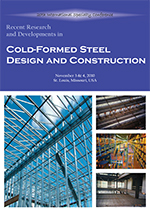Session Dates
03 Nov 2010
Abstract
This paper summarizes recent work to determine if the LRFD resistance factor for cold-formed steel compression member s can be increased above its current value of φ c =0.85. An experimental database of 675 concentrically loaded columns with plain and lipped C-sections, plain and lipped Z-sections, hat sections and angle sections, including members with holes was compiled. The predicted strength of each specimen was calculated with the AISI-S100-07 Main Specification and Direct Strength Method (DSM). Test-to-predicted strength statistics were employed with the first order second moment reliability approach in AISI-S100-07 Chapter F to calculate the resistance factors. The observed trends demonstrate that DSM is a more accurate strength predictor than the current Main Specifica tion, especially for columns with partially effective cross sections. Serious consideration should be given to replacing the Main Specification with DSM, which would provide improved prediction accuracy and a viable rationale for increasing the resistance factor. The test-to-predicted strength ratios for columns with plain and lipped angle cross-sections exhibit a high coefficient of variation and b ecome increasingly conservative with increasing global slenderness. Fundamen tal research on the mechanics of angle compression members is needed to improve existing design methods.
Department(s)
Civil, Architectural and Environmental Engineering
Research Center/Lab(s)
Wei-Wen Yu Center for Cold-Formed Steel Structures
Meeting Name
20th International Specialty Conference on Cold-Formed Steel Structures
Publisher
Missouri University of Science and Technology
Document Version
Final Version
Rights
© 2010 Missouri University of Science and Technology, All rights reserved.
Document Type
Article - Conference proceedings
File Type
text
Language
English
Recommended Citation
Ganesan, Karthik and Moen, Christopher D., "Evaluating the LRFD Factor for Cold-formed Steel Compression Members" (2010). CCFSS Proceedings of International Specialty Conference on Cold-Formed Steel Structures (1971 - 2018). 2.
https://scholarsmine.mst.edu/isccss/20iccfss/20iccfss-session2/2
Evaluating the LRFD Factor for Cold-formed Steel Compression Members
This paper summarizes recent work to determine if the LRFD resistance factor for cold-formed steel compression member s can be increased above its current value of φ c =0.85. An experimental database of 675 concentrically loaded columns with plain and lipped C-sections, plain and lipped Z-sections, hat sections and angle sections, including members with holes was compiled. The predicted strength of each specimen was calculated with the AISI-S100-07 Main Specification and Direct Strength Method (DSM). Test-to-predicted strength statistics were employed with the first order second moment reliability approach in AISI-S100-07 Chapter F to calculate the resistance factors. The observed trends demonstrate that DSM is a more accurate strength predictor than the current Main Specifica tion, especially for columns with partially effective cross sections. Serious consideration should be given to replacing the Main Specification with DSM, which would provide improved prediction accuracy and a viable rationale for increasing the resistance factor. The test-to-predicted strength ratios for columns with plain and lipped angle cross-sections exhibit a high coefficient of variation and b ecome increasingly conservative with increasing global slenderness. Fundamen tal research on the mechanics of angle compression members is needed to improve existing design methods.



